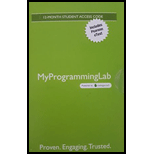
Concept explainers
To explain how the polymorphism enables “in general” rather than specific ad also to explain its key advantages in
Explanation of Solution
Polymorphism is a Greek word where ‘poly’ means many and ‘morphism’ means forms. Thus, polymorphism is defined as the ability to acquire many forms. It can be used to develop programs which processes class objects that belong to same hierarchy of class as if all objects belong to base class in the hierarchy.
In polymorphism the base class object is set equal to the sub class objects. Thus, the base class behaves differently depending upon the functionality of sub classes.
Polymorphism helps us to ‘program in general’ and not ‘in specific’.
The advantages enabled by Polymorphism to program ‘in the general’ are given below:
- It focuses on general operations applied to all objects constructed from a class in the class hierarchy.
- It helps provide a general behavior in the code that can be used by all subclasses besides the specific code of each subclass that distinguish their functionality.
- It enables us to separate the general code from the specific code.
- It also facilitates the code extension by including new features in the class without such modification.
- The base class contains a set of member functions which all the subclasses inherit and provide their own definitions.
The advantages of programming “in general” are given below:
- It supports the re-usability of the code.
- The code can be easily extended and new functionality can be added to the existing code without such modification.
- It also helps in reducing the complexity of the code.
- It provides robustness in the program.
Want to see more full solutions like this?
Chapter 20 Solutions
MYPROGRAMMINGLAB WITH PEARSON ETEXT
 C++ Programming: From Problem Analysis to Program...Computer ScienceISBN:9781337102087Author:D. S. MalikPublisher:Cengage Learning
C++ Programming: From Problem Analysis to Program...Computer ScienceISBN:9781337102087Author:D. S. MalikPublisher:Cengage Learning C++ for Engineers and ScientistsComputer ScienceISBN:9781133187844Author:Bronson, Gary J.Publisher:Course Technology Ptr
C++ for Engineers and ScientistsComputer ScienceISBN:9781133187844Author:Bronson, Gary J.Publisher:Course Technology Ptr- Programming Logic & Design ComprehensiveComputer ScienceISBN:9781337669405Author:FARRELLPublisher:Cengage
 EBK JAVA PROGRAMMINGComputer ScienceISBN:9781337671385Author:FARRELLPublisher:CENGAGE LEARNING - CONSIGNMENT
EBK JAVA PROGRAMMINGComputer ScienceISBN:9781337671385Author:FARRELLPublisher:CENGAGE LEARNING - CONSIGNMENT EBK JAVA PROGRAMMINGComputer ScienceISBN:9781305480537Author:FARRELLPublisher:CENGAGE LEARNING - CONSIGNMENT
EBK JAVA PROGRAMMINGComputer ScienceISBN:9781305480537Author:FARRELLPublisher:CENGAGE LEARNING - CONSIGNMENT





